|
Guests at Mount Pulaski Courthouse
learn about pre-Civil War weaponry
 Send a link to a friend
Send a link to a friend
 [July 15, 2022] [July 15, 2022]
On Saturday afternoon a modest number of local
history buffs interested in pre-Civil War era firearms gathered on
the lawn of the Mount Pulaski Courthouse to hear from Jim Leinicke
and see the large assortment of rifles and muskets he had brought
with him. All the guns were from the pre-Civil War era and Leinicke
entitled his talk “The evolution of Firearms 1848-1855.”
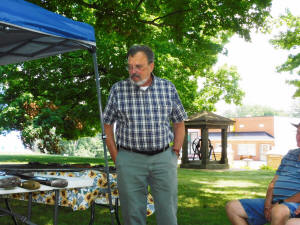
As he began his talk, Leinicke noted that the years 1848 to 1855
were the years that the Mount Pulaski Courthouse was an active
courthouse and Mount Pulaski was the county seat of Logan County.
Leinicke noted that the firearms on display were from that time
period and before. He said that in the history of firearms the
concept changed little in the 75 years prior to that time frame, but
changed a great deal in the time frame afterward.

Seventy-five years prior to 1848 would have been the Revolutionary
War era. He said that at that time, the muskets used by soldiers
were hard to load. This is why that when going into the battle
field, soldiers would line up shoulder to shoulder in multiple rows.
The first line would fire, then the second line or row would move
forward and fire, and so on and so forth. The lines would keep
advancing toward one another until all the rounds had been fired and
then the battle would continue on with bayonets, or the troops would
retreat.
As time progressed, the development of paper wads was developed
along with flint spark triggering mechanisms that made loading and
firing quicker.
Leinicke noted that early rifles and muskets did not have a long
firing range. Another development in firearms was rifles that had a
longer firing range making it easier for soldiers to fire at a safer
distance from the opponents.

One interesting point that Leinicke shared was about a flood in
London. He said that most firearms were made by craftsmen,
blacksmiths by trade. They received the parts to make and assemble
the guns, then shipped them back to the military.
When there was a flood in London, all the guns manufactured were
water damaged. They were disassembled, cleaned and restored as best
as possible, then the parts were put into large bins in the Tower of
London. When a craftsman was ready to assemble the guns, he would
tell the keeper of the parts how many guns he could make, and the
parts for each gun were counted out from the bins. The original
firearms had numbers engraved in specific locations after they were
assembled. With the tear down of the completed guns, parts were
thrown into the bins with no attention paid to those numbers.
Consequently, the restored or reconstructed guns would not have
matching numbers, which proved they were a second generation weapon.
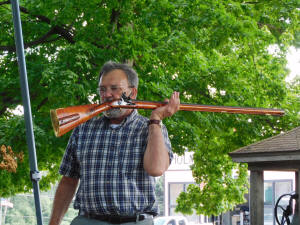

[to top of second column] |

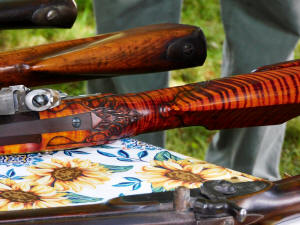


Leinicke said that the craftsmen who did the wood working for the guns were very
proud of their products and many of the guns were made of beautiful woods with
ornate metal work and engravings in the wood.
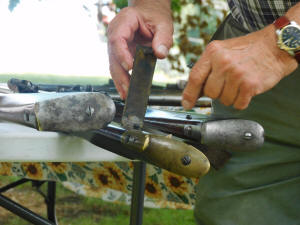
Leinicke was asked about the hinged lids on some of the rifles. He said that
there was a history behind those lids. The lids open up to a small compartment
where tools or gun grease would be stored, making it convenient for the soldier
to do quick maintenance or repairs on his gun. He said that for a time,
manufacturers decided that the compartments were not necessary and stopped
installing them. But, those who carried the rifles were unhappy about the change
and wanted the compartments brought back. So, the compartments came back for a
time, then finally went away for good.
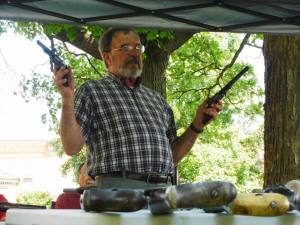
Leinicke said one of the best inventions during the early days of firearms were
pistols. The repeating five- and six-shooters were popular because they were
pre-loaded with bullets and could be fired quickly.
However, the military did not often provide the pistols because the soldiers
fired too many rounds too quickly and ammunition was costly. However, eventually
rifles were developed that also provided that multiple loading capacity.
Leinicke explained that the bullets were loaded into the butt of the rifle and
then the gun could be fired, the case ejected, and another bullet would slide
into place for another round of fire.
In the 75 years following 1855 there were huge advances made in firearm
technology. Leinicke explained that by World War I machine guns, tanks, fighter
airplanes and dirigibles were in use, changing the way wars were fought.
Leinicke spoke for about 90 minutes about the many muskets and rifles he had on
display. Afterward, he invited guests to come up to the tables and get a closer
look at the firearms he had brought with him.

_small.jpg)
Mount Pulaski Courthouse Site Manager Steve Martin thanked everyone for
attending and invited all to go inside the courthouse for refreshments.
[Nila Smith] |